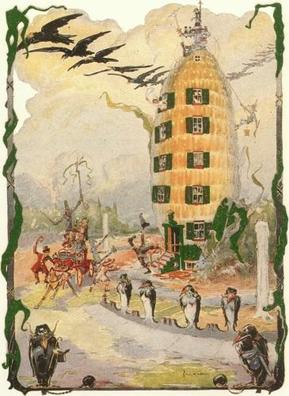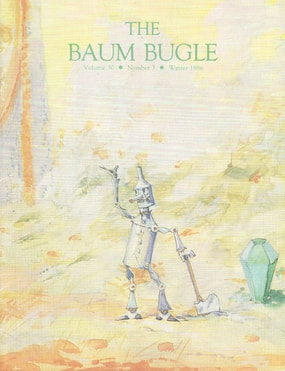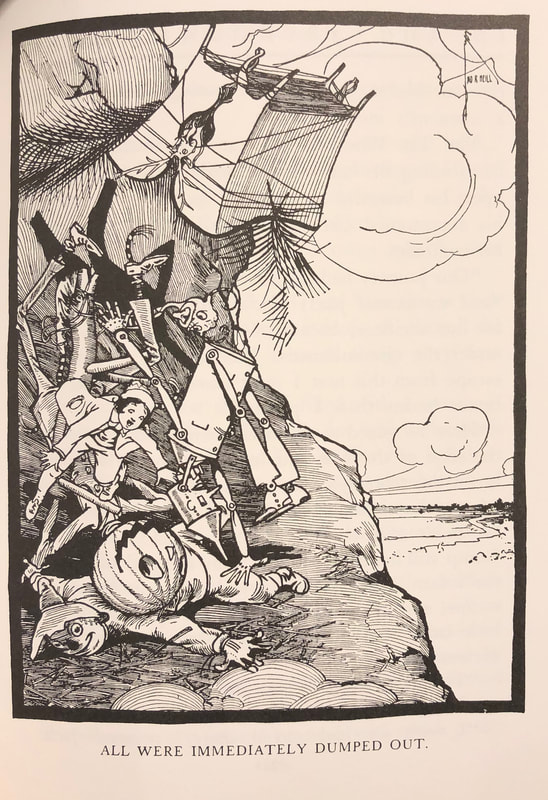|
One of the central fascinations at the center of the "Lost Art of Oz" search is that, with the exception of the artwork created by WW Denslow for THE WONDERFUL WIZARD OF OZ (much of which was gifted to the New York Public Library in 1926), all of the original artwork created for the Oz Book series was retained by the publisher, Reilly and Lee. So in looking at what has survived and what else might be 'out there,' the game often becomes trying to determine the 'how' and the 'when' individual pieces started going AWOL from the R&L archive. A common practice for turn-of-the century marketing of children's books was for major retailers to create prominent window displays featuring for-sale books along with pieces of original illustration. Usually oversized and drawn on sturdy Bristol Board the artwork was an easy, eye-popping and inexpensive way to draw young eyes, and publishers were happy to lend them, with the caveat (sometimes honored and occasionally not) that they be returned when the promotion was over. A popular legend in the Oz Collecting world is that a series of original watercolors created by John R. Neill in 1910 for THE EMERALD CITY OF OZ were loaned to Marshall Field & Co., an upscale department store in Chicago, to advertise the book but were never returned, only to be discovered decades later in the company's basement.
Someone else who managed to commission an original piece of Oz artwork from John R. Neill was an impassioned Ohio based radio writer named Jack Snow. Corresponding with fellow Oz collector, Roland Baughman in January of 1942, Snow shares his great pride in obtaining it. The original John R. Neill watercolor in Jack Snow's collection was not from an Oz book, but was later reproduced in the Winter 1986 edition of The Baum Bugle.  Jack Snow Jack Snow So, it's perhaps not surprising that the next known documentation of original Oz series artwork being in private hands would be in a note from Snow. In a January 9, 1947 letter to a collector named William G. Lee (no relation to the publisher), Jack writes: "I have The Land of Oz, first edition, presentation copy in dust wrapper with four original Neill illustrations." Before he was done collecting, Snow would end up with a second first edition MARVELOUS LAND in a dust jacket (which may play a part in our story later on). Despite his passion for Oz, which extended so far as to writing two books in the series (THE MAGICAL MIMICS IN OZ in 1946 and THE SHAGGY MAN OF OZ in 1949, as well as a readers guide called WHO'S WHO IN OZ in 1954) the later years of Snow's life were marked by tragedy and economic hardship. By 1955, he had sold most of his collection to prominent New York dealers Howard Mott and Gabriel Engel. Though it's inconclusive what became of the four original Neill illustrations from the MARVELOUS LAND OF OZ in Snow's collection, it seems likely that three of these (along with the endpapers drawn by WW Denslow for Baum's DOT AND TOT IN MERRYLAND, and 8 assorted 1904 drawings by Denslow for a short lived comic strip based on the characters of The Scarecrow and the Tin Man) were purchased in November of 1955 by Roland Baughman for Columbia University (the subject of our previous blog). The cost for the 12 drawings was $400 (about $3,782 in 2018 dollars) which shows the relative low valuing of the original artwork at that time. A far more impressive price was placed on Snow's two first edition, dust jacketed copies of THE MARVELOUS LAND OF OZ, which were offered by Mott for $200 each. One of these copies would be obtained by Oz illustrator and collector, Dick Martin. Also in Martin's collection was an original illustration from THE MARVELOUS LAND OF OZ, featuring Tip admiring the newly formed Jack Pumpkinhead. Across the board is a crack, almost identical to fractures in the illustrations purchased for Columbia University. Could this be the fourth original illustration from Snow's collection? If so, it might be the first piece of original Oz series artwork connected to Dick Martin. It would certainly not be the last, as we will explore in our next blog. Special thanks to Cindy Ragni of The Wonderful Books of Oz, Bill Campbell and The Oz Enthusiast and
The International Wizard of Oz Club for images featured.
1 Comment
The road to tracing the existing original artwork created by John R. Neill for the Oz series is more often than not a scavenger hunt. It starts with a lead, which leads to a lot of inquiry work, and occasionally - just occasionally - results in an undiscovered treasure. Such was the case of a recent search in the vaults of Columbia University. Now, Neill, himself, retained none of the illustrations he drew for the Oz books. They were expressly the property of the publisher, Reilly & Britton (later Reilly & Lee, and later still Regnery and then Contemporary Books). By the time Contemporary sold the last of its Oz archives in the early 1980s, but a tiny fraction of the original artwork was left. It's largely believed most of the artwork was purged by the publisher in the early 1960s, and so it's always intriguing to learn of a collection in private or public hands that pre-dates that time period.  The first major exposition of L. Frank Baum's work was in 1956 at Columbia University, and it was the brainchild of Roland Baughman, who was the Head of the Department of Special Collections at Columbia, and a fervent collector of L. Frank Baum and Oziana himself. The exhibit contained books and a few pieces of original artwork by Denslow and Neill that Columbia purchased specifically for the exhibition. In the decades since the exhibition, the drawings have been housed with the effects of Roland Baughman's papers (gifted to Columbia upon his death in 1961) and as is often the case with Neill's art, misidentified in the school's records. Thanks to the efforts of the dedicated staff at the Butler Library, the works were traced and brought out of the vaults, for what may have been their first viewing in a very long time. Still encased in the inexpensive black wooden frames they were put in for the 1956 exhibit (and covered in decades worth of dust), the three illustrations from THE MARVELOUS LAND OF OZ nevertheless remain- well, absolutely marvelous. The first drawing, featuring Tip and Jack Pumpkinhead sleeping on the side of a hill, while the Saw Horse watches nearby corresponds to the colored plate on page 56 of the published volume. Neill, incidentally, with the exception of his watercolors for THE EMERALD CITY OF OZ and DOROTHY AND THE WIZARD IN OZ did all his works in pen and ink on Bristol Board, with the colorization happening later (and by other hands) in the printing process. This work is especially notable in it's homages to traditional Denslow flourishes; in particular, the outline of a larger than life sun overhead may have been Neill's attempts to mirror the style of his highly successful predecessor on the Oz series. The second sketch of Tip, Jack and the Sawhorse crossing a river is intriguing in that it is the only original art for a half-page sized illustration that is presently known to have survived from MARVELOUS LAND. A fun surprise is seeing that despite the rather small size of the illustration in the published book, Neill took an entire full-sized board to craft the drawing! Neil apparently made some changes to the design of this illustration as there is an 'insert' piece of paper pasted on the middle of the board and drawn over. Both illustration boards unfortunately have major damage to them; large cracks cross the entire length of the image. Interestingly, this damage corresponds to a similar split on another illustration board from LAND sold at auction in recent years, and would indicate the damage may have been sustained in the storing of the works at the publishing house. How the works came to leave Reilly and Britton remains a mystery... The third illustration from MARVELOUS LAND is on a slightly smaller board (and one with a slightly different sheen). Though familiar, there was something instantly 'off' about the image, but it took a moment to realize what it was. When compared to the finished illustration in the published book, something is missing. Can you see what it is? Ah yes! It's our old friend, H.M. Wogglebug T.E., MIA from the pen and ink illustration! But what could that mean? Is this illustration at Columbia a copy? A drawing for an abridgment of the story in which the Wogglebug doesn't appear? Or was this a preliminary drawing done by Neill that perhaps was rejected upon the realization that a major character from the episode was missing?
An early (and persistent criticism) L. Frank Baum had of John R. Neill's work was that he failed to astutely observe the details in his narration. While we may never know what exactly is the story behind it, it seems likely that this was (perhaps the first) instance in which Baum finger wagged his new illustrator for not closely reading his story. |
AuthorBrady Schwind is a writer, director, and Oz Enthusiast on a mission to definitively catalogue the existing original artwork from the famed "Famous Forty" Oz books. Archives
November 2023
Categories |











 RSS Feed
RSS Feed
